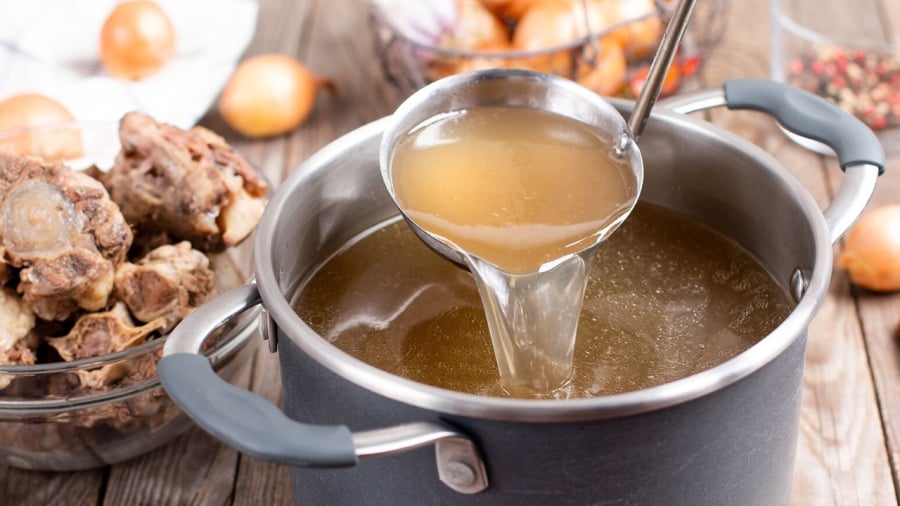Nutritional Composition of Bone Broth
According to Healthline, the nutritional content of bone broth can vary depending on the ingredients and preparation methods, but it typically includes the following:

Bone broth used for making pho
Protein and Amino Acids: Bone broth is a source of collagen, a protein that breaks down into gelatin during cooking. Gelatin provides amino acids such as glycine and proline, which are essential for the body.
Minerals: Bone broth may contain minerals like calcium, magnesium, phosphorus, and potassium, although the amounts may not be significant.
Electrolytes: The sodium and potassium in bone broth can help balance electrolytes and hydrate the body.
A 240mg serving of beef bone broth contains 39 calories, 9g of protein, 1g of fat, and small amounts of calcium, iron, and potassium.

Bone Broth
Health Benefits of Bone Broth
Supports Bone and Joint Health: Bone broth is rich in collagen, an important component of cartilage. Regular collagen intake can promote joint health and reduce symptoms of arthritis. Essential minerals like calcium, magnesium, and phosphorus are crucial for maintaining bone density.
Aids Digestion: The gelatin in bone broth contains glutamine, an amino acid that supports the intestinal barrier and can help manage issues like leaky gut syndrome. Some studies suggest that bone broth may reduce inflammation and support digestive health.
Promotes Skin Health: Collagen plays a vital role in maintaining skin elasticity and hydration. In addition to topical collagen application, consuming collagen through dietary sources like bone broth can improve skin health from within.

Bone Broth Simmering
Potential Risks of Bone Broth
While bone broth is generally safe, there are a few considerations to keep in mind:
Heavy Metals: Animal bones may contain heavy metals like lead. Some studies indicate that bone broth could contain trace amounts of these metals, but usually within safe limits.
High Sodium Content: Store-bought, canned, or pre-made bone broths often contain high amounts of salt and may not be suitable for those on a low-sodium diet. Preparing bone broth at home allows for better control over the sodium content.
Allergies and Food Sensitivities: Certain components in bone broth may trigger allergies or sensitivities for some individuals.
Minimizing Risks Associated with Bone Broth
According to Medicinenet, to reduce the risk of lead contamination in bone broth, consider the following:
– Choose Bone Sources Carefully: Opt for bones from animals raised in clean environments with minimal exposure to heavy metals. Animals grazing on contaminated soil or consuming polluted feed are more likely to accumulate lead.
Diversify Ingredients: Combine various types of bones and connective tissues to dilute potential contaminant concentrations.
Moderate Consumption: Sensitive individuals, such as pregnant women and children, should consume bone broth in moderation to minimize potential risks.
The Super Nutritious Part of the Pig: A Hidden Treasure
Introducing the ultimate superfood, a unique delicacy derived from pork. This special part of the pig is believed to possess potent properties, especially when paired with beer. Together, they create a dynamic duo, a “tonic” of sorts, that is highly revered by gentlemen for its perceived invigorating qualities.






































